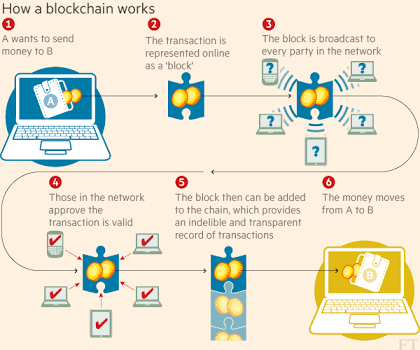blockchain[1][2][3] – originally block chain[4][5]– is a distributed database that is used to maintain a continuously growing list ofrecords, called blocks. Each block contains atimestamp and a link to a previous block.[6] A blockchain is typically managed by a peer-to-peer network collectively adhering to a protocol for validating new blocks. By design, blockchains are inherently resistant to modification of the data. Once recorded, the data in any given block cannot be altered retroactively without the alteration of all subsequent blocks and the collusion of the network. Functionally, a blockchain can serve as "an open, distributed ledger that can record transactions between two parties efficiently and in a verifiable and permanent way. The ledger itself can also be programmed to trigger transactions automatically."[7]
Blockchains are secure by design and are an example of a distributed computing system with high Byzantine fault tolerance.Decentralized consensus has therefore been achieved with a blockchain.[8] This makes blockchains potentially suitable for the recording of events, medical records,[9][10] and other records management activities, identity management,[11][12][13] transaction processing, and documenting provenance.
The first blockchain was conceptualised bySatoshi Nakamoto in 2008 and implemented the following year as a core component of the digital currency bitcoin, where it serves as the public ledger for all transactions.[1] The invention of the blockchain for bitcoin made it the first digital currency to solve the double spending problem, without the use of a trusted authority or central server. The bitcoin design has been the inspiration for other applications.[1][3]

